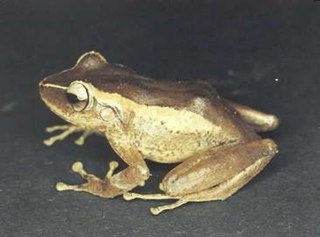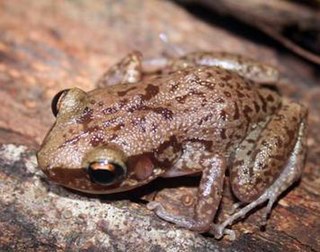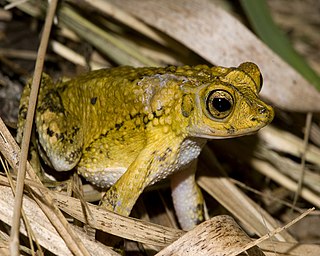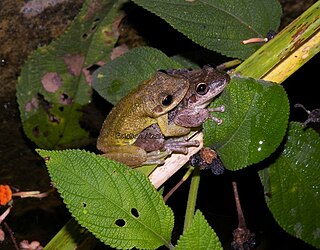 W
WThe bronze coqui, Richmond's coqui, coquí caoba, or coquí de Richmond is a species of frog in the family Eleutherodactylidae. The specific epithet, richmondi, is dedicated to Dr. Charles W. Richmond.
 W
WThe common coquí or coquí is a species of frog endemic to Puerto Rico belonging to the family Eleutherodactylidae. The species is named for the loud call the males make at night. This sound serves two purposes. "CO" serves to repel males and establish territory while the "KEE" serves to attract females. Since the auditory systems of males and females respond preferentially to different notes of the male call, this is an example of a sex difference in a sensory system. The common coquí is a very important aspect of Puerto Rican culture, and it has become an unofficial territorial symbol of Puerto Rico.
 W
WThe cricket coqui, green coqui, or coqui grillo is a species of frog in the family Eleutherodactylidae endemic to Puerto Rico. Its natural habitats are subtropical or tropical moist lowland forest and subtropical or tropical moist montane forest.
 W
WThe dwarf coqui or elfin coqui is a species of frog endemic to Puerto Rico. It is placed in the subgenus Eleutherodactylus.
 W
WEleutherodactylus juanariveroi, the Puerto Rican wetland frog or, is an endangered species of coqui, a frog species, endemic to Puerto Rico. It was discovered in 2005 by Neftalí Rios, and was named after Puerto Rican herpetologist Juan A. Rivero, in honor of his contributions to Puerto Rican herpetology. It is only found in the old Naval Base of Sábana Seca in Toa Baja, Puerto Rico. It is characterized by a high-frequency, chip-like sound, a light-brown skin color, and a strip between the eyes. It is the smallest species of coqui.
 W
WEleutherodactylus portoricensis is a frog native to Puerto Rico that belongs to the family Eleutherodactylidae. Its vernacular English names are upland coqui, mountain coqui, and Puerto Rican robber frog. It is found in the Toro Negro State Forest and other similar mountainous regions.
 W
WEneida's coquí is a species of coquí, a small variety of frog endemic to the main island of Puerto Rico and its archipelago. Known as coquí de Eneida in Puerto Rico, this amphibian is mainly terrestrial. Its average adult size is from 1.0 to 1.2 inches. It has a number of small warts located across its back and eyelids. Its main color is a light tone of greenish or grayish brown with a yellow tint on its underbelly. They often have a pair of light colored concave lines located on their backs. Their eyes are golden or green colored, generally dark colored with black venal reticulation. Its habitat is located in mountains that are 1,000 to 3,000 feet above sea level. This species seems to have suffered a population reduction, in the process disappearing from areas formerly considered its natural habitat. The reason behind this reduction is under study, and Eneida's coquí has been designated an endangered species until the cause is discovered. This population decrease is not considered to be linked with the loss of its habitat, which has prevented the protection of its habitat.
 W
WThe grass coqui or coqui de las hierbas is a species of frog in the family Eleutherodactylidae, endemic to Puerto Rico. Its natural habitats are subtropical or tropical moist lowland forest, subtropical or tropical moist montane forest, subtropical or tropical seasonally wet or flooded lowland grassland, plantations, rural gardens, and heavily degraded former forest. It is threatened by habitat loss.
 W
WHedrick's coqui, the treehole coqui, or coqui de Hedrick is a species of frog in the family Eleutherodactylidae endemic to Puerto Rico. Its natural habitats are subtropical or tropical moist lowland forest and subtropical or tropical moist montane forest.
 W
WLeptodactylus albilabris is a species of frog in the family Leptodactylidae. Its local name is ranita de labio blanco or sapito de labio blanco and English name either Gunther's white-lipped frog or Hispaniolan ditch frog. It is found in Hispaniola, Puerto Rico, the British Virgin Islands, and the U.S. Virgin Islands.
 W
WThe melodius coqui or coquí melodioso is a frog species in the family Eleutherodactylidae endemic to Puerto Rico. Its natural habitats are subtropical or tropical moist lowland forest and subtropical or tropical moist montane forest. It is threatened by habitat loss.
 W
WThe Mona coqui,, Eleutherodactylus monensis, is a species of frog in the family Eleutherodactylidae endemic to Mona, Puerto Rico. Its natural habitats are subtropical or tropical dry forest and subtropical or tropical dry shrubland.
 W
WThe Puerto Rican crested toad, or simply Puerto Rican toad, is a species of toad found only in Puerto Rico and the Virgin Islands. It is the only species of toad native to Puerto Rico and the Virgin Islands. The species formerly occurred in Virgin Gorda and along the southern and northern karst in Puerto Rico. It is listed as a threatened by the US Fish and Wildlife Service due to habitat loss and introduced species. At one period of time it was believed to be extinct until it was rediscovered in 1966. The IUCN has the species listed as critically endangered.
 W
WThe Puerto Rican rock frog, Eleutherodactylus cooki, also known as the Puerto Rican cave-dwelling frog or rock coqui, and locally as coquí guajón, or guajón for brevity, is a threatened frog species from the coqui genus. This unique species of tropical frogs dwells primarily in crevices and grottos in the Cuchilla de Panduras mountain range in southeastern Puerto Rico. The native name guajón is derived from its habitat, guajonales, which are caves formed by rock formations between huge stones. Despite being the state animal and considered emblematic of the region, of the 17 species of coquí, three are believed to be extinct and the rest are rare and declining in numbers. The Puerto Rican rock frog is extremely restricted in geographical distribution. The frog is threatened due to deforestation, agricultural, rural, and industrial development, and the associated infrastructure. It is sometimes called the “demon of Puerto Rico" because of its eerie call and phantom-like appearance. The species was first described by American herpetologist, Chapman Grant in 1932.
 W
WThe red-eyed coqui, churi, coqui churi, or coqui de las Antillas is a species of frog in the family Eleutherodactylidae that is found in Puerto Rico, the British and U.S. Virgin Islands, and introduced to Panama. Although there are many similar species that are endemic to these tropical locations, its unique physical, habitual, and behavioral characteristics distinguish it from other members of the genus Eleutherodactylus. This genus contains around 185 species that are located in the southern United States, Central America, South America, and the Caribbean, with 16 different species endemic to Puerto Rico. The red-eyed coqui was not brought into Panama City from its native habitats until the late 1960s. There it became established in urban parks before it began to colonize outside the city in the 1980s. In Puerto Rico, the largest island inhabited by the red-eyed coqui, it is found up to 1,200 meters above sea level. It is often compared to the common coqui, Puerto Rico's unofficial territorial symbol, but upon a closer ecological look, the red-eyed coqui has many differences.
 W
WScinax ruber is a species of frog in the family Hylidae. It is known in English as the red snouted treefrog or red-snouted treefrog, sometimes also Allen's snouted treefrog, the latter referring to the now-synonymized Scinax alleni. This widespread species is found in much of Amazonian and northern coastal South America and into Panama, as well as in some Caribbean islands as introduced populations. It is a complex containing several cryptic species.
 W
WThe web-footed coqui, stream coqui, Puerto Rican stream frog, or Karl's robber frog, Eleutherodactylus karlschmidti, is a possibly extinct Puerto Rican frog species in the family Eleutherodactylidae. It was first described by Chapman Grant in 1931, and was named after herpetologist Karl Patterson Schmidt. It is the largest Eleutherodactylus species of Puerto Rico.